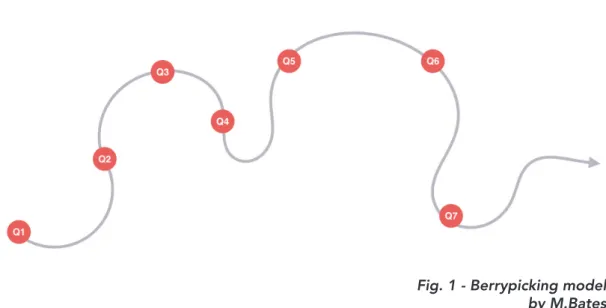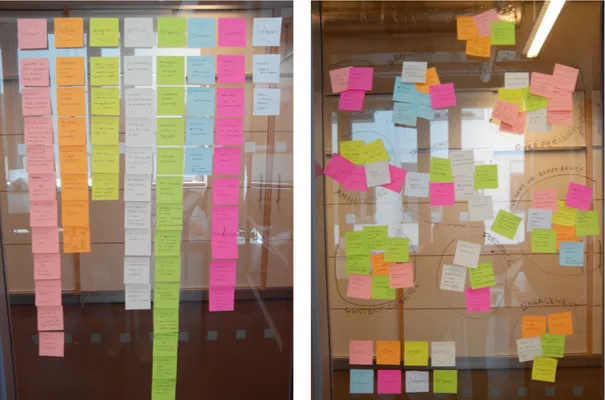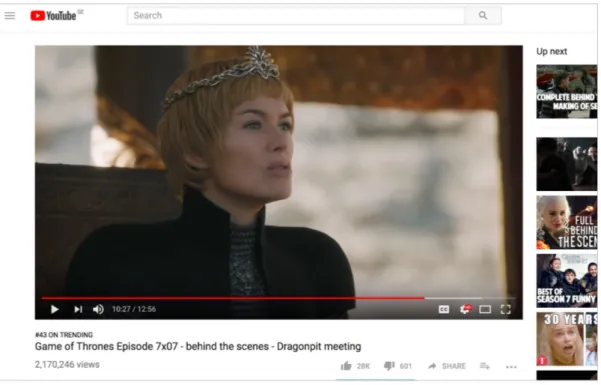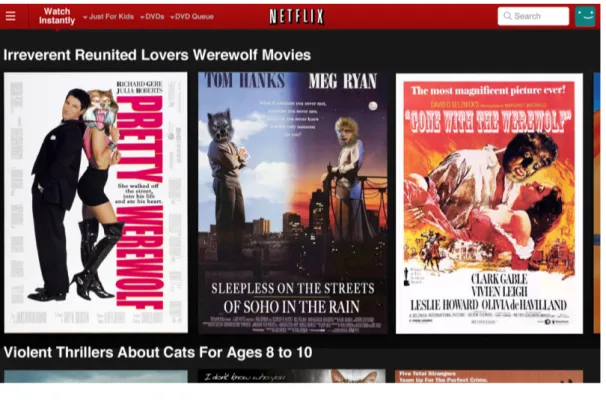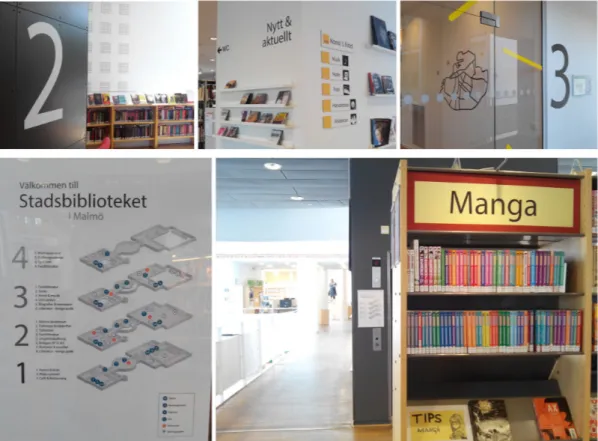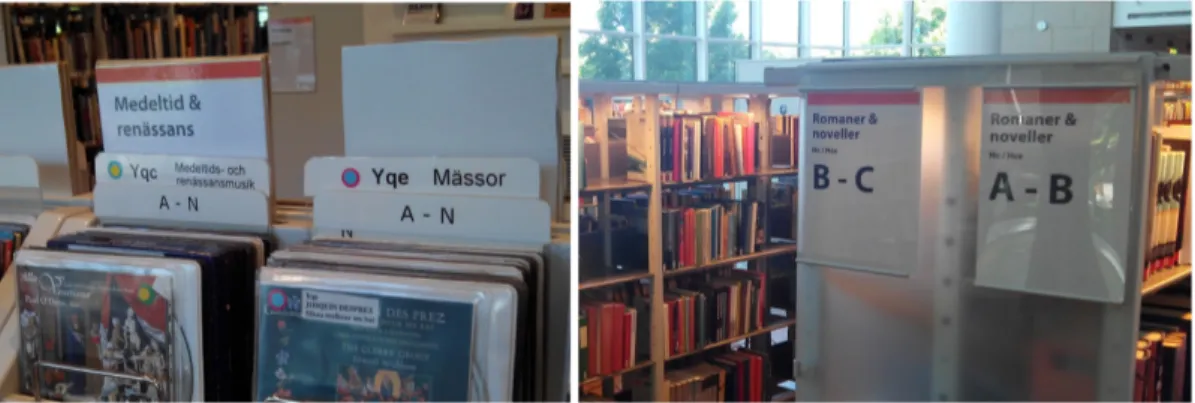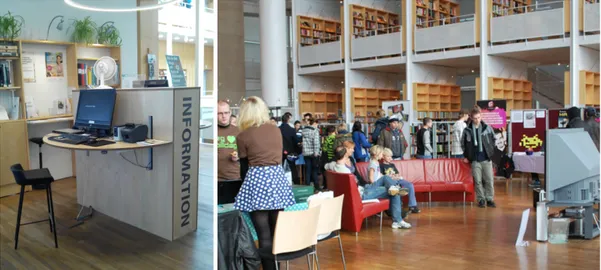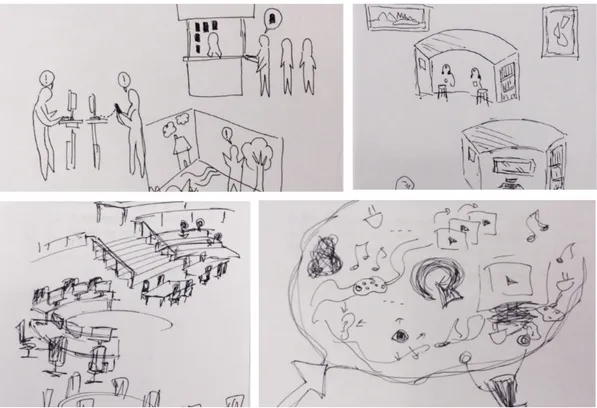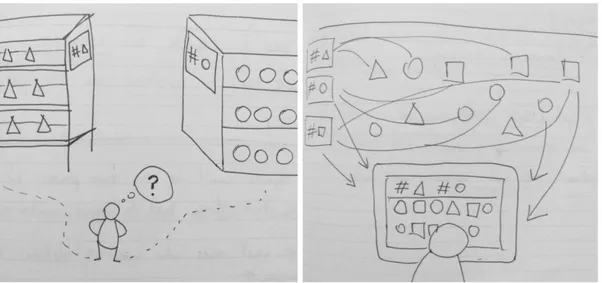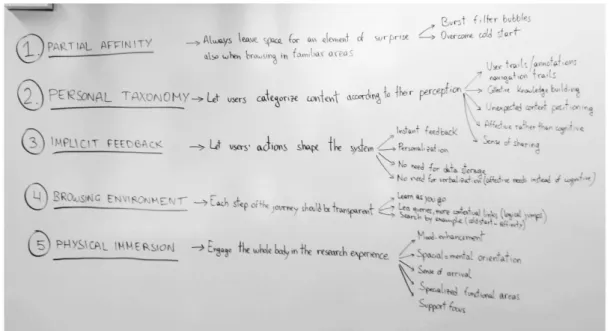Interaction Design One-year Master’s Programme
Thesis Project I, 15 credits August 2017 Supervisor: Clint Heyer
Bianca Di Giovanni
Lost&Found Videothek
Non-ubiquitous video library
for serendipitous
retrieval of movies
A design exploration for the introduction of
folksonomy in the physical space
Acknowledgments
I would like to thank my supervisor Clint Heyer who with few words has drastically changed my approach not only to this project, but also to the way I look at interaction design.
I would also like to express my gratitude to my classmates, colleagues and roommates, who were ready to help in the times of need.
Finally, I am most grateful to my parents, whose support has been enduring and always more than I deserved and to my brother, who has been my major inspiration for the entire course of my studies.
Abstract
Lost&Found Videothek is the concept for an interactive video library thought for
users engaged in an exploratory research mode, in which content is organized according to a collaborative, subjective and implicit indexing system for the enhancement of serendipity. This idea was the result of a design-based research with a user-centered approach in the field of information retrieval. With the use of design methods such as heuristic UX evaluation, co-sketching, and other original design experiments, the project aimed at identifying the most valuable qualities of physical and digital libraries in order to integrate them within one retrieval system.
Table of contents
1.
2.
3.
4.
5.
6.
INTRODUCTION
BACKGROUND
2.1. Literature reviewInteractive information retrieval Design for serendipity
Knowledge environments and social spaces Indexing non-textual information
2.2. State-of-the-art Recommender systems Bookless libraries 2.3. Methodology Methods
FIELD RESEARCH
3.1. Evaluation of digital libraries Partial affinity
Implicit feedback Idiosyncratic genres
3.2. Immersion in a physical library 3.3. Survey 3.4. Focus group Co-sketching Group discussion
CONCEPT DEVELOPMENT
4.1. Problem definition4.2. Synthesis and design brief 4.3. Experiments
Experiment 1: Exploratory
Experiment 2: Subjective and physical Experiment 3: Collaborative and implicit
PROJECT OUTCOME
5.1. Final result 5.2. Perspectives 5.3. DiscussionCONCLUSION
REFERENCES APPENDICES5
6
7 10 1113
13 17 19 2023
23 24 2531
31 32 3334
35 371. Introduction
Lost&Found Videothek is a physical alternative to streaming and video on-demand
online services. Although it may seem to match rather well the values of a post-digital society, by reading the design process that inspired this concept, it should distinctly appear that this should not be accounted as a nostalgic design piece. Lost&Found Videothek is a public video library with a specific peculiarity: users cannot search for movies, they can only encounter them.
Context
The overwhelming amount of video content accessible online has led to the devel-opment of highly-specialized information-filtering systems which attempt to predict users preferences with as much accuracy as possible. These recommender systems are meant to create perfect instant matches between users and items by interpret-ing a variety of information that the users may submit both intentionally and not intentionally, in order to optimize the searching process in terms of time and quality of the result. The implementation of such sophisticated tools has been possible thanks to the integration of the research in information retrieval with the study of information-seeking behaviour. Yet, some researchers claim that in the develop-ment of such systems the user-oriented approach has tended to take a backseat in favour of a system-oriented approach (Neal, 2012) and, while this led to remarkable accuracy, a variety of valuable qualities might have gone lost.
Research aim
In this thesis we aspire to define and investigate the most valuable qualities of the searching experience of users engaged in an exploratory, open-ended research of affectively charged content such as movies.
Being design the main mode of inquiry, the process will use a variety of tools and participatory design methods for the evaluation and analysis of current best prac-tices in order to find an answer to the following research questions:
What tools does design offer to give digital libraries a shape that preserves the positive qualities of physical libraries?
How can a digital library be transformed from a document repository into a knowl-edge environment?
During the course of the field research, which explored both digital and physical libraries, we will dig into the concepts of serendipity, physicality, subjectivity, collab-orative and implicit indexing. From the synthesis of these concepts we will continue with a design exploration through a series of three original experiments.
In conclusion, we will apply our findings to a real case scenario of users in search of movies recommendations, from which the concept of the video library will emerge.
2. Background
In order to understand our modern approach to information-seeking and how to-day’s sophisticated information-retrieval systems work, it might be worth taking a few steps back and seeing how the theoretical discussion within information sci-ence has evolved more or less together with the technological tools. In fact we may say that today’s recommender systems are the descendents of the very first OPACs (Online Public Access Catalogs) of traditional libraries. Such catalogs have started becoming more and more powerful search tools, and being suitable to collect a wider and wider variety of material, not only books, but any conceivable type of content. Taking a quick tour on the internet today we will find easy access to thou-sands of digital libraries displaying collections of items of all sorts: photos, videos, music, clothes, recipes, furniture… However, the accessibility of such an incommen-surable amount of content, would not result in an empowerment of the generation of the so called information era, if an adequate information management had not been implemented. On the contrary, it would lead to on the one hand devastating information overload, on the other hand the impossibility to retrieve any relevant information.
While computer scientists seem to have done a very fine job avoiding this calamity, a more focused study on information behaviour may further reduce side effects such as information overload and filter bubbles. In order to ensure the right balance between accuracy and novelty it is necessary to reach a good understanding of user information needs and information consumption. Once it is clear how users interact with information, we may proceed with the development of an efficient indexing system.
In the specific case of movies we shall take into account that 1) it may be very challenging for users to articulate well-aimed needs and 2) the use of audio-visual content is highly affect-driven. Therefore, movies retrieval shall not be approached as a task-oriented research, but rather as an open-ended exploratory activity where users are likely to change their mind several times during the course of the process and are consequently very prone to let chance encounters deviate their attention from their original goal.
Unlike recommender systems, browse environments may represent a more suited solution for the above mentioned information behaviour. In fact, while the higher degree of freedom they offer to the users may raise the feeling of uncertainty, the lack of over-personalization may ultimately be of great benefit, by enabling more meaningful interactions among both content and users and by unlocking opportu-nities for serendipitous discoveries.
According to Cool and Belkin (2011) we can start talking about interactive infor-mation retrieval when the two distinct fields of ‘inforinfor-mation retrieval’ and ‘infor-mation-seeking behavior’ were reunited in one discipline studying the interactions of people, information and information retrieval systems. While the former more computational area had been given great importance, the latter, rather concerned with information science, had been left aside. This resulted in the tendency to eval-uate IR systems on the basis of the one criterion of accuracy of response to a certain query. However, an increasingly user-centered approach brought IR to the attention of information scientists. In an excursus about the evolution of research models Russell-Rose and Tate (2013) highlight very clearly how since the 1970’s system-cen-tered classic model up to now greater emphasis has been given to the user. What are the motivations behind seeking behavior? How are information needs articulat-ed by users? How do they interpret and evaluate the information they encounter? All these aspects started being taken into consideration and started clarifying that people’s understanding of their information needs changes during the course of an information-seeking episode (Ruthven, Kelly, 2010). Furthermore they are highly subjective and depend on the particular information seeker.
In this perspective the ‘berrypicking’ model (Bates, 1989) started being very popu-lar, as powerful metaphor for the iterative nature of information retrieval. “The que-ry is satisfied not by a single final retrieved set, but by a series of bits of information [...] As picking berries in the forest, they do not come in bunches, one must pick them one at a time.”
2.1. Literature review
2.1.1. Interactive information retrieval
Fig. 1 - Berrypicking model by M.Bates
Although the idea of a nonlinear model is applicable to most seeking episodes it is particularly accurate in the case of users engaged in an exploratory research mode. This is the case of seekers whose needs are unclear since the beginning of the research process. “The information need will almost certainly change as they discover information and learn, and the gap between their current knowledge and their target knowledge narrows.” (Spencer, 2006)
When we have no special information need or interest, research is typically char-acterized by browsing behaviors. Browsing is an activity where we do not lead an aimed research but rather expose ourselves to possibly novel information. In such a fuzzy mode understanding the affective state of the user is particularly valuable. In the six stages of information-seeking identified by Kuhlthau (1991) the ‘exploration’ is the phase characterised by an increase in uncertainty and feeling of anxiety. In this state the user is more likely to lose focus and give up the research, but this same feeling of uncertainty is also the necessary ground for initiating the sense-making process (Dervin, 1983).
Interpreting and finding a meaning for the information encountered is a turning point in the seeking process, in which users start feeling optimistic again. However, there is a further possibility that may release the stress associated to the exploration stage. Sometimes users encounter useful information without having identified any specific need. These happy encounters create what is called a serendipitous feel-ing. Serendipity is obviously auspicable, but hard control. However, Burkell, Quan-Haase and Rubin (2012) identified specific conditions for serendipitous discoveries to occur and proposed aimed design tools to enhance them.
Moving the exploration process beyond predictable facts retrieval is also encour-aged by Marchionini (2006) and Ge, Delgado-Battenfeld and Jannach (2010) sug-gest serendipity as an evaluation criterion for recommender systems beyond rele-vance or accuracy.
Blandford and Attfield (2011) in their comprehensive work on how people use, interpret and manage information also present a designerly approach to support sense-making and serendipity in information-searching with a stress on interaction. A valuable insight of their research is how the natural layout of traditional libraries support serendipity. They observe that having to walk past stacks of items that do not meet the research query is an opportunity for chance encounters. What they suggest is that “novel design solutions are unlikely to be purely digital, but to ex-ploit the rich variety of information resources, digital, physical and social, that are available.” In fact the role of communities to develop new information practices is another focal point of their dissertation as they notice that “the majority of informa-tion interacinforma-tions take place within a social context”.
2.1.2. Designing for serendipity
serendipity that we discussed above, this inversion signified a much more profound loss of opportunities for interaction, also and perhaps most importantly between individuals. The advent of Web 2.0 offered a chance to fill this gap, but it is still far from replacing the role a physical space.
Lambe (2010) explains that “an information and knowledge environment such as a portal or intranet, should ideally resemble a city in the way that it works”. His concern is that over-standardization may bring efficiency, but it suppresses diversity of use, while what he defines a knowledge environment should have the ability to support a wide variety of use.
In “Knowledge Lost in Information” Larsen (2003) communicates the urge to em-power the next generation by transforming digital libraries from simple document repositories into complex and dynamic infrastructures. Despite his commitment to-wards the completion of the concept of Ubiquitous Knowledge Environments, even he recognizes that “As information becomes ubiquitous and our lives transcend local surroundings, human beings remain rooted by a strong sense of place”. Finally Lueg and Bidwell (2005) identify an analogy between berrypicking and real world wayfinding and argue that “Embodiment as a constituent of human-informa-tion interachuman-informa-tion also appears to be worth more attenhuman-informa-tion as more recent perspec-tives in cognitive science question the traditional separation between mind and body, and also the separation between body and environment. Spatial arrange-ments can contribute to enabling human cognitive capabilities and help reduce task complexity.”
The way content is categorized is the main determinator of how information is re-trieved. When it comes to non-textual information Neal (2012) offers a rich analysis of the challenges of indexing music and images. For supporting users in retrieving songs she identifies a fundamental mistake in the attempt to classify affective con-tent such as music within the boundaries of genre. When information needs are other than cognitive, users should not feel constrained to articulate them according to standard formats. This appears to be in agreement with Bates (1989) when she states that “systems should be sufficiently flexible to allow the user to adapt the information seeking process to his own current needs. Not reflect rigid assumptions about the user’s goals.”
Also Xia Lin (2006) stresses the importance of content representation and how it should be more tightly coupled with interaction. In other words, the use people make of content should define the way it is classified. Understanding how people naturally use information should be a priority before developing retrieval systems. For instance, individuals tend to make subjective associations between content be-longing to different genres as “Notions of similarity will vary by individual.”(Neal, 2012).
With this in mind Neal’s insight is that democratic tagging offers a valid help to em-brace the fuzziness of people’s understanding of genre and it may compensate the strictness of top-down indexing systems. This user-centric knowledge management is also known with the name of folksonomy a rapidly developing phenomenon on 2.1.2. Indexing of non-textual information and folksonomies
Web 2.0, resulting by the more and more common practice of users of sharing orig-inal content on social media. Such growing amount of content called for a cheap and effortless indexing technique, which lead to the creation of for example the popular hashtag.
Peters and Becker (2009) widely discuss strengths and weaknesses of the appli-cation of folksonomies to information retrieval. Despite the lack of accuracy and trustworthiness of democratic tagging, they recognize the merit of giving users the benefit of someone else’s past experience. Through tags, users are brought together and facilitated in the discovery of communities. People with similar tag-ging behaviors may in fact show related taste. This not only enriches the browsing experience, but it also makes it more effective.
Recommender systems are a subclass of information filtering systems that attempt to predict the rating that a user would give to a item. Such technology is applied to a variety of areas including movies, music, news, books, research articles, search queries, social tags, and products in general. (Ricci, Rochak, Shapira, 2011)
Nowadays RSs shape the information that we encounter all over the internet, but some of the most successful and advanced examples can be found in Netflix, You-Tube, Amazon, Spotify, Google Search... just to mention few. Each of them rely on specialized algorithms that aim at retrieving automatically what they assess might be the most relevant items for the users. A more in-depth analysis of the way they work can be found in the chapter on the field research about digital libraries.
Bookless libraries are public, mostly college libraries that do not contain any print-ed material. Instead, they offer a variety of digital mprint-edia for consulting scientific and academic research material. (Reema, 2013) The concept of libraries with no books is starting to spread also outside the confine of academias, which is predict-ably raising a harsh argument that this is going to lead to a cultural impoverishment of society. However, besides the debate around the future of paperless society and whether or not material books are ever going to be replaceable, what we find of particular interest in this example is the value that this concept gives to the spacial dimension, also in the perspective of an entirely virtual repository. Besides the ac-cess to devices for the consumption of digital material, such as tablets and comput-ers, a bookless library offers a place for interaction, where students can still meet up, do group-work and most importantly publicly expose information behaviors.
2.2. State-of-the-art
2.2.1. Recommender systems
Ironically enough, the retrieval of serendipitous design works is much more chal-lenging than that of theorizations of how to design for serendipity. If not because the current design repertoire is still quite slim (at least compared to computer sci-ence), it might be due to the fact that the word serendipity is so widely applied and so easyto misuse.
Among the works worth mentioning we found Serendipcity, thesis project of 2014 by Jorge Brake from ITP New York. Serendipcity is a travelling app that encourages serendipitous exploration and discovery of city neighborhoods. The mobile app provides engaging walking route to your destination, rather than suggesting the fastest one by generating itineraries based on location, time available and prefer-ences. Brake is interesting as it challenges the value of efficiency intended as time optimization, by contributing to the user experience with enjoyment and explora-tion of the space instead.
An example that demonstrates the value of shaping space for the sake of enhanc-ing serendipity and social interaction is the recent effort of an increasenhanc-ing number of companies to design their workspace in order to raise the likelihood of “collisions“ between co-workers. Following the idea that informal chance encounters can en-able more profiten-able collaborations and creativity occurs “at the edge of chaos conditions”, many CEOs have abandoned the clean desk policy to adopt a more innovative and flexible approach. Telenor for example affirmed that incorporating “hot-desking”(non-assigned seats) improved communication and accelerated de-cision-making. Installing few, but strategically placed coffee machines and central toilets or building more narrow halls are other tactics used to make collegues lit-erally bump into each other and be encourage to networking. (Waber, Magnolfi, Lindsay, 2014)
Another attempt to create a vibrant, collaborative environment to promote cre-ativity can also be found in the architecture school at Bond University designed by Peter Cook of CRAB Studio in London, who commented “We need to be design-ing spaces that are not predictable and where there are unexpected, interestdesign-ing things going on. It is about ensuring the environment creates a context where people are capable of being themselves, giving of their best and are not intimi-dated.” (Sander, 2012)
Although these cases do not represent proper interaction design examples, they are expression of a designerly mindset to social innovation where human interac-tion is the main focus, which are of great interest for the purpose of this research.
As a design-based research work, this project takes place “at the delicate balance between what exists and what could exist” (Löwger, Stolterman 2004). With the at-tempt to stay open to envisioning novel solutions and to avoid to build on the basis of assumptions, the basic approach has been “designing without final
goals”(Si-2.3. Methodology
The first phase of the field research was based on an immersion and a heuristic evaluation of digital and physical libraries. A journal has been used to keep track of the findings. Later on an in-situ inquiry has been conducted on 20 library users, who answered a questionnaire with a mix of qualitative and close-ended questions. Because of the ambiguity of the answers of the participants to the survey, a focus group was held to find a common interpretation and reach a better understand-ing of the topics arose from the study. The discussion has been initiated with a co-sketching session, to warm up participants and stimulate free-thinking. Each step of the field research has been followed by sessions of cognitive mapping to make sense of the findings. Finally, when a design opening started appearing, a series of design experiments brought the exploration to concept development and design synthesis.
2.3.1. Methods
mon, 1996) with the outcome of the project aiming to be actually understanding the problem and generating new goals (Obrenović, 2011).
For this reason a proper definition of the design problem appears rather late in the process, after an iterative process heavily based on exploration, where inquiry has not stopped after the first steps, but has continued during the course of experi-menting with elements of possible future, to reach only at last a comprehensive understanding of the current scenario.
3. Field research
In this step we arbitrarily selected eight of the most popular digital libraries pres-ent online today, including: Google, Youtube, Amazon, Netflix, Spotify, Wikipedia, Pinterest and Instagram. Each of them are highly complex infrastructures of infor-mation, so the analysis has tried to focus as much as possible on the evaluation of their IR system primarily in terms of UX and what tools they use to satisfy the user requests and how far they manage to enrich the research journey of a serendipitous feeling.
Such analysis has been carried out mostly by the researcher (only participant) using the systems in actual context and complementing the research with the reading of specialized articles for a deeper understanding of both technological aspects and marketing choices.
All the knowledge acquired during the course of this phase of the research has been first grouped system by system and then mapped in clusters of feature presenting similar techniques or goals. This facilitated the identification of the practices that appeared more relevant for the sake of our research. In the following chapters we will present more in detail three of the most interesting findings.
3.1. Evaluation of digital libraries
The ultimate challenge of RSs is guessing what each user would consider relevant information. Relevance is however very subjective and it depends on a variety of factors. One of the easiest and most effective ways to ensure relevance is delivering suggestions based on popularity. If people talk about a topic, it is very likely that most users will find it worth spending time on. This is a model that works very well for most systems. However, it has a huge flaw. First of all promoting popularity is a loop that feeds itself, secondly it flattens taste and perception, treating users as an indistinct blob without individual preferences. We should be aware that recom-mended content shapes people’s taste, not only vice-versa.
However, when a RS has no data about a user, suggesting popular content is its best guess. As soon as more information is collected about a user, past activity starts having more and more weight in the algorithm. Unfortunately also recom-mendations too based on history end up being predictable and not very valuable. Over-personalization is a well-known problem of Netflix, whose Product Leader Chris Jaffe once stated in an interview in 2016 with Business Insider “We don’t really care if you watch ‘Jessica Jones’ or ‘Marco Polo’, we just want you to watch” (O’Reilly, 2016). Pinterest seems to slightly suffer from the same issue. When strate-gic decisions are made with the only goal of ensuring engagement the result is that we end up trying to please users to the point that we are not making them a favor anymore. Referring to filter bubbles Eli Pariser (2011) states “A world constructed by the familiar is a world in which there’s nothing to learn [...] invisible propaganda indoctrinates us with our own ideas”. So maybe the role of a UX designer is not always and necessarily pleasing users, but also sometimes challenging them. This is where chance encounters come into place. Unfortunately serendipity cannot be guaranteed, only encouraged, but some systems, like Spotify or Amazon seem to have found a good trade off between risk and reward, by providing suggestions based only on partial affinity.
Another crucial factor concerns the way users assess the content they come across. Most of the libraries under analyses have different feedback mechanisms. Items can be liked, disliked, rated, starred, saved, commented. However, the way people use these tools cannot be completely trusted. The two main issues consist in the fact that 1) most people are quite unlikely to engage in an activity that does not give them immediate reward; 2) explicit rating is often “aspirational, rather than reflect-ing your daily activity”(Gomezo, 2013). With this in mind it appears more obvious why the most effective systems are the ones that rely on implicit feedback. In these systems users spontaneous actions are considered as declarations. For instance, clicking on an item shows interest; watching a video from start to end means real engagement; and saving a song in your playlist is the ultimate sign of appreciation. Not having to give a thumb-up or score is both effortless for the user and more valuable for data analysts, since preferences declared in a pre-reflective state of mind are more likely to be sincere and offer more insight.
3.1.2. Implicit feedback
Fig. 5 - Youtube recommended videos based on engagement
Another good practice found in our evaluation is the use of cross-genres and id-iosyncratic genres. The basic idea consists of grouping items in clusters that go beyond the confines of traditional genres, but spot similarities based on all sorts of associations that users may make between items. The sample systems taken into analyses apply this principle both with a top-down approach, where curators propose non-standard categories to classify content (see Netflix) and bottom-up, where the way users collect items provides a glimpse of how they associate items (see Spotify playlists and Pinterest boards). If with the term “speed” the system 3.1.3. Idiosyncratic genres
filters 90’s punk bands and violin virtuosos from the XVII century, it might not be considered an “accurate” categorization, but it has done something valuable, at least creating the conditions for possibly enlightening chance encounters.
Fig. 6 - Parody of Netflix creative genres
The immersion has taken place in the municipal sity library of Malmö, Sweden. Malmö stadsbibliotek counts 14,000 m2, which makes it the largest public library in the Nordic countries in terms of area and it reports 950,000 annual visits. It was opened in 1946 but in recent years it was re-designed to put more emphasis on the creation of experience spaces that invite people to stay at the library and make use of other offers apart from borrowing materials. In particular the re-design of the children’s area - Balagan- has been a great success as realization of an environment where physical and digital coexist to make children’s experience of the library in-teractive and stimulating. For its innovative character, it might sound like a stretch calling Malmö stadsbibliotek a traditional library, but it certainly represents a skillful architectural execution that takes into account human interactions. In the below sections we present some of the aspects that were positively evaluated.
Wayfinding system
When browsing in a traditional library a transition from one area of interest to another corresponds to moving in space. For this reason we found that a clear way-finding system may be an aid not only to spatial orientation, but also to initiate sense-making.
3.2. Immersion in a physical library
Alphabetical order
Vicinity is an interesting property of physical space. In a collection of material items, it is very unlikely to find isolated objects. When we browse through the shelves we cannot hide the items that do not match the query that we have in mind. We will almost certainly skim our fingers on objects we were not looking for. Additionally, the necessity to organize items in alphabetical order, even though belonging to the same field of interest, will add an element of chance between each item and its closest neighbour.
Functional areas
As mentioned above Malmö library puts great focus in the creation of experience space. Taking a look around it appears very clearly how each corner has been de-signed to serve a special need. Study desks, medialab, relax area, reading chairs, children’s area, open space, forum, cubicles. Each of them create a different atmo-sphere aimed at enhancing specific moods.
People
As simple as that, physical libraries remain a meeting place for the people. Either if we engage in longer conversations or in a quick acknowledgment of each oth-er’s presence through simple eye-contact, it is unavoidable to interact in a way or another with other individuals. Knowing that we are sharing the same space with others affects our state and has an impact on our behavior.
Additionally, unlike in digital libraries, the help desk offers an immediate source of reassurance. Its presence represents technical and personal support, security and vigilance for the users.
Fig. 11-12 - Malmö Stadsbibliotek information desk, community event
The observation of the service offered by Malmö Stadsbibliotek lead to the for-mulation of a series of assumptions about how other users perceive and value the library. In order to confirm or confute such intuitions, a survey was conducted on a sample of 20 users.
The participants were interrogated as they approached the exit of the building at different hours and different days of the week in the month of July. Males and females were asked indistinctively and their age was registered between 20 and 38 years old. Close-ended questions concerning age, profession and number of annual visits to the library were asked as a context to more accurately interpret their words, rather than for any statistical purpose.
The final goal of the survey was understanding how people value, use and perceive the space of the library and the material that it offers.
Findings
Almost the totality of the participants stated that they have at least once used the library only for the space and not for the material that it offers. However, only two of them usually consult the material borrowed in the library, without bringing it home. When asked how well they know what they are going to search when entering the library, they were quite evenly split between those who knew exactly what they were going to borrow and those who had only a vague idea.
Paper books were the only media that all the participants claimed of using on a regular basis.
As for the motivation that drives them to the library, a large majority affirmed that they were interested in finding quiet and a place to focus. A few of them also men-tioned internet connection and a space group work.
When it comes to words association, the most recurrent terms used to describe the space of the library where: quiet, cozy, clean, inspirational, big, open.
In conclusion participants were asked to comment on the following quote from a Forbes article written by Tim Worstall in 2014:
“More titles, easier access and quite possibly a saving of public funds. Why wouldn’t we simply junk the physical libraries and purchase an Amazon Kindle Unlimited sub-scription for the entire country?”.
Although surprisingly the majority affirmed they agreed with Worstall at least par-tially, the ones against him showed strong resentment and brought counter-argu-ments with much more determination.
The points in favor were the following: easier access to knowledge; unlimited re-sources; more up-to-date content; more personalized content. On the other hand, being physically immersed in a place of culture as a library seemed to have a great value to many users. The social role of the physical library was mentioned by many. Some participants also said that they do not like the idea of depending on technol-ogy and brought up conspiracy theory about the unreliability of digital data.
In order to get more insight from the findings of the survey, a focus group was or-ganized with 5 interaction designers, including the mediator who took annotations of the most salient points of the conversation. Before opening the discussion, a
The following co-sketching technique is called Visual Phone or drawing telephone and it has been used in the Human Centered Design workshop by IDEO.
1) Each participant was given three sheets of paper. 2) Everyone was asked to write on the first sheet a detailed definition for ‘bookless library’ (none of the partici-pant had heard the term before). 3) The first sheet with the definition was passed clockwise. 4) The next person read the sentence and was asked to illustrate it with a quick sketch on the second blank sheet placed on top. 4) The sketch, hiding the first paper, was passed clockwise one more time. 5) On the third and last sheet each person wrote a new definition from the interpretation of what they saw in the illustration. 5) Everyone read out loud the first definition and compared it with the final one.
Although all the four participants declared before the exercise that they did not know what a bookless library was, each of them gave a rather accurate first defini-tion, except for one participant who did not explicitly define it as a physical space. The final definitions did not differ radically from the original one, however, we found that having to interpret a rough sketch full of ambiguity did add some interesting new features and generally activated a creative mind. It was also interesting how the four participants focused on the four different aspects of spatial, social, digital and multi-sensorial experience.
3.4.1. Co-sketching warm up
Approach
After the participants had a hint of the theme of the focus group with the warm up exercise, in order to initiate the discussion, they were presented with the same Worstall’s statement included in the survey and in addition the following two quotes extracted from the answers of the survey, which appeared the most insightful for the purpose of our research, but could benefit of a more exhaustive explanation.
“A library is much more than a collection of resources. A book is much more than the story printed on its pages”.
“There is a pleasure in the feeling of holding a book that someone else has already read before you”.
It was clear how hard it is for people discussing of the value of physical libraries, without falling into an attitude of defence of their romanticized image of books and their privileged status of true beholders of knowledge and wisdom. However, we tried as resolutely as possible to not look at the mistake of reducing a book to a single digital page, but rather at the issue of compressing a complex physical envi-ronment into an interface.
Conclusion
All the participants agreed that it is true that we are attached to the concept of physical libraries because of tradition, but for a traditional library to be of any value for the community, just like a digital one, it needs to be a well-designed one. If it is not designed for the people, it is just a repository of material. However, the spatial dimension adds more to it. It is important that they are public, large spaces. A small booth placed somewhere in the city redistributing content, would not be much dif-ferent from a database or cloud. A large public space becomes also a social gath-ering point. It encourages the organization of events. It becomes a way to promote local activities and, being open to everybody, a public library is an equalizer. This deeply shapes the community. It defines how people share space and do activities together. Witnessing other people striving for self-improvement is a mutual inspi-ration. The physicality of it is what makes the creation of this silent connection be-tween people possible. A virtual space does not have the same property. The con-cept of sharing without the physical aspect changes meaning. Although the word sharing is nowadays more widely used in the digital world, sharing digital content does not have the emotional value of sharing something physical, such as space. 3.4.2. Group discussion
4. Concept development
In the light of the results obtained in the desk and field research, we might take a look again at the research questions and see it from a new perspective.
How might we integrate the positive qualities of physical and digital libraries to cre-ate a system of movies retrieval that also fulfills the role of knowledge environment?
In a nutshell, the most interesting quality that arose from the evaluation of digital libraries is the possibility to create a folksonomy, whereas analysing a traditional library we concluded that the very physicality of it is the most fundamental value. By summing these observations together we start seeing a design opening which we believe might bring our research further.
Could it be possible to replicate the equivalent of a folksonomy in a physical en-vironment? After a series of sketches and cognitive maps, a main challenge was identified for the realization of such a concept.
The main challenge consists in the fact that folksonomies are made possible tahnks to the ubiquitous quality of digital content. On the other hand, physical objects cannot be in several places at the same time. Hence, with the constraints of physical libraries being that categories correspond to shelves, an item cannot be on differ-ent shelves at the same time. In other words, even if several tags are attached to it, only one at a time can be applied. If just the voice of one person counts in the classification, the tagging cannot be called democratic. What is more, when such tag is subjectively chosen by the user, retrieval becomes a challenge.
Fig. 14-15 - Field research findings, cognitive mapping and sketching
In synthesis of all the discoveries and insights gained during the process so far and having acknowledged what the challenge is, the research may proceed trying to create an indexing system that fulfills the following attributes:
1. Exploratory. It is targeted to users whose information needs are not explicitly articulated and do not derive from a given cognitive task.
2. Subjective. Content should not be grouped in objective categories created with an altruistic purpose of attempting to help others retrieve information. On the op-posite, the classification should be subjective, expression of the personal experi-ence and perception of the individual.
3. Collaborative. The classification of the content should be the result of a social activity, where the experience of several individuals overlap and complement each other.
4. Implicit. Users shall not be required to do anything more than what they would naturally do in a browse environment. The configuration of the taxonomy should be the result of implicit actions from which their intentions may be inferred.
5. Physical. The system should be integrated in a public space, physically accessible by the users. The items, despite their digital nature, shall not be ubiquitous, but they should behave in space like physical objects. They may be moved, but not duplicated, therefore they can occupy only one position at a time.
Fig. 16 - Field research findings, conceptual mapping
The ultimate goal of the project is to combine the above mentioned attributes with-in one organic system. In order to break down this compounded task with-into smaller objectives, a series of three experiments have been designed to first address single or couples of attributes separately. In this phase we approached the problem with a half analytical half synthetical mind-set. After exploring possibilities and unfolding the research even further, both on a behavioral and technical level, we expect to have enough grounding to address the puzzle as a whole and find a more organic design solution.
4.3. Design experiments
The first experiment looks into the concept of exploratory searching behavior. It is an adaptation of the popular game “Wikirace”, in which players start from the same randomly pre-selected article and try to arrive in the shortest amount of time to another given article only by clicking links within their current page. In our case the basic difference is that, since we are dealing with an open task, the goal is not optimizing time, but maximizing the result.
Description
4 participants took part in this experiment.
1. Each participant was assigned one of the following browse environments: Wiki-pedia, Youtube, Pinterest and Instagram.
2. Everyone was given 5 to 10 minutes to find an image, a video or an article that they considered worth sharing with the rest of the group with the only restriction 4.3.1.Experiment 1: Exploratory
of having to proceed in the navigation only by clicking links, hashtags and related items and without ever using the searchbox input.
3. At the end of the 10 minutes each participant showed their findings to the rest of the group and explained their decision.
Participant 1 - Instagram
The participant that was assigned Instagram stated that his navigation was driven by his own interest. While he started browsing mindlessly, every time he encoun-tered something he could relate to he would have the feeling “I’m getting closer” and clicked on it until he had a clear “hah” moment when he found an illustration he had seen before but felt like was sticking out from the rest. He described the overall experience as pleasant.
Participant 2 - Wikipedia
The browsing behavior of this participant was mainly driven by curiosity. The links she clicked through were always words she had never heard before and found in-triguing. She reported a moment of frustration when she had the feeling she was lost and could not find anything interesting enough for the rest, but it resolved into satisfaction when she finally discovered an article that we all agreed on defining rather bizarre.
Participant 3 - Youtube
The participant who browsed through YouTube immediately expressed frustration, as she felt the videos she was being recommended were keeping her in a loop. While in a first phase she had a tendency to click on things that would match her interests, in a second phase she started looking for videos that could be new for everyone. She also stated that if she had not been asked to share her finding with others, she would have kept lower standards in her selection. Additionally she did not appreciate the time limit as videos take longer to assess.
Participant 4 - Pinterest
The last participant found the entire experience very frustrating, mainly because he felt like he could not escape the recommendations given by the algorithm which made him feel very limited in his choice. Furthermore, when he found interesting images, but continued browsing, he had a hard time getting back to them and got lost several times.
Conclusion
The two participants who had to deal with a recommendation algorithm did not ap-preciate the limits that it imposed and tried to escape it. Both relatability and novel-ty gave users a positive feeling and lead their research, in some cases alternatively. The pressure of having to share content with others had an impact on the metrics of judgment, mostly making it more demanding. Despite having a rather open task two participants felt lost at times, which made them experience uncertainty.
Fig. 17 - Experiment 2, subjective categorization This experiment tries to explore how people categorize affective content and how they adapt and understand other users’ subjective indexing system. It should be noted that the aspect of physicality is here meant not as embodiment, but rather as the restriction of non-ubiquity.
Description
1. Users A and B were given a folder with 26 images. The images were all chosen for having an affective value, but other than that they were random and unrelated. 2. Both A and B were asked to define three categories of their choice and to create three corresponding folders to organize the 26 images accordingly.
3. After having split the images among their own categories, both users were asked to do the same but within the categories that the other user had chosen.
Result
User A chose two subjective indices ‘funny’ and ‘cute’ and one objective ‘places’, while user B defined two objective ones ‘staged’ and ‘compositions’ and one sub-jective ‘spontaneous’.
In the classification A, user B agreed with user A 18 out of 26 times. In the classifi-cation B, user A agreed with user B 13 out of 26 times.
Classification A Funny Places Cute User B matches A 9 out of 14 5 out of 7 4 out of 5 Classification B Staged Spontaneous Compositions User A matches B 3 out of 9 4 out of 9 6 out of 8
Conclusion
We may conclude that indices that should be assessed objectively, like ‘places’, did not result in a univocal opinion, as people, having a different background and sensitivity notice and prioritize different details, especially when looking at content with an affective charge.
In the third and last experiment we looked into how people may index content collaboratively and how this may be done implicitly, meaning without the specific intention of creating a categorization, but trying to infer it from a pre-reflective behavior.
Description
This experiment counted 9 participants.
1. In the first step 5 users were given a folder with the same 26 random images of the previous experiment.
2. Each participant was asked to pick the five images that they found the most at-tractive and send them back in an untitled folder.
3. Another user, F, was presented with the five untitled folders with the images picked by the previous five users and she was asked to rename each folder with any word or set of words to describe the main theme of each collections.
4. The last three users K, H and E were shown five images, picked randomly one from each of the five renamed folders and they were given two tries to guess to which of those five folders each image belonged.
5. After K, H and E were told the result of their performance, they were asked where on Plutchik’s wheel of emotions they would collocate the experience and in general how they felt about the task.
Result
After a first moment of confusion due to the randomness of the images select-4.3.3.Experiment 3: Collaborative and implicit
each set had something to say about the personality or the eye of the person who had chosen them. On this basis she named them with the labels ‘Advertisement’, ‘Love’, ‘Memories’, ‘Teenage’, ‘Time’.
User K guessed correctly 3 out of 5 images at her first try and 5 out of 5 at her second try. She afterwards described the task as easy and fun and she pointed ‘op-timism’ on the emotion wheel.
User H guessed only 1 out of 5 at first, but when she was given another chance she also could place correctly 5 out of 5. She identified the experience as ‘interesting’ and she found the task relatively easy, although at times she felt very indecisive as some images seemed to belong to more than one category.
At his first try user E did not make any right guess, while with a second attempt he could successfully place 4 out of 5 images. He later affirmed that he did not have any immediate association between the given images and categories and felt slightly forced to choose one. On the emotion wheel he indicated the word ‘inter-est’ to describe how he felt about the task.
Fig. 18 - Experiment 3, collaborative and implicit indexing
User K User H User E Try 1 3 out of 5 1 out of 5 0 out of 5 Try 2 5 out of 5 5 out of 5 4 out of 5
Fig. 19 - Plutchik’s wheel of emotions
Conclusion
In the step 3, the indexing, the fact that user F managed to attach meaningful la-bels to randomly chosen sets of images, which also other users found useful for the purpose of retrieval, shows that, even when asked to make purely emotional and non-rational decisions, our actions are driven by a perceptible logic or at least some type of consistency.
As for the retrieval phase it is noticeable how at their second try all participants recorded a significant improvement. As soon as they found out that their first guess was wrong, they immediately knew what the next most likely guess could be. Which means that even when users categorization collides, on a priority scale they still agree on some level.
Furthermore, none of the users experienced negative feelings, which might be be-cause of the little engagement that the task required, but it should also be consid-ered that, being a task-driven activity they were under a performance pressure that would not occur in an open-ended research.
5. Project outcome
After having established five attributes that fulfil the values identified by the users in the field research concerning the retrieval of affective content, and having tested their effectiveness through a design iteration counting of three experiments, the exploration was concluded with the formation of a concept that could be applied to a real life scenario.
Concept
Lost&Found Videothek is a public physical video library specifically designed so that users cannot find movies if they are looking for them, unless they encounter them. The videothek has no catalog or online search engine accessible to the users for the intentional retrieval of specific items. The space is divided in sections where panels are placed following a similar maze-like layout of the shelves of a traditional library. To each panels are attached a series of beacons, bluetooth radio transmit-ters.
Users are required to download the app of the Videothek for reading the data transmitted by the beacons. Each beacon is associated with a movie. When users place their smartphone close enough to one of them they are displayed an inter-face with the cover image and the title of the movie and the possibility to see more basic information about the movie such as a short plot or a video of the trailer.
5.1. Final result: Lost&Found Videothek
The movies are initially associated randomly with the beacons. However, users have the capacity of swapping the position of a movie, depending on their following ac-tions. For instance, if one lingers in front of movie A, then proceeds through other panels and stops again in front of movie B for a reasonable amount of time, the user that comes next will find that movie A and B have gained proximity. This way each user leaves a trace and the pattern of their research partly shapes the indexing sys-tem. After several users have explored the videothek, the cumulative effect of their actions will have defined a configuration of the entire database accordingly with their interest. However, the system remains dynamic, every time a user has access to it, it will have a new slightly different configuration.
Users may express interest in a movie also explicitly though the app, by adding a bookmark to remind themselves of the ones that caught their attention. This way, if their location is changed by other users, the movie is not lost.
When a user decides for a movie, they can decide if watching it privately at an individual booth equipped with laptop screen, headphones and an armchair or, if available, in a room for public screening for groups.
Fig. 22-23 - Lost&Found Videothek beacon technology, individual booths
The concept presented in this thesis has reached only a very early stage of proto-typing, heavily leaning towards the role corner of the prototypes triangle and with a hint of look and feel. For an actual implementation, technical aspects should be considered and tested.
of the room could be designed to enhance moods and try to channel users into flows.
Moreover, the idea of users walking around lead by their smartphones is not en-tirely satisfactory, as it is rather acknowledged that smartphones tend to break that silent connection between people that we are here so attentively trying to nourish. Future perspectives might look further into possible alternatives and start an evalu-ation from the point of view of the embodied interaction.
As a result of the design process, we found a fertile meeting point between current technologies and innate seeking behavior, for the creation of a space where the iterative nature of the research journey is re-established. In Lost&Found Videothek data is not brought straight to the users. On the contrary, users are deliberately encouraged to take the steps towards an exploration designed for initiating the sense-making process that will assist them though the progressive clarification of their information needs. This way we discharge the retrieval system from the re-sponsibility of creating strict formats for the formulation of requests that by nature are not cognitive. The outcome is a flexible browse environment, free of filter bub-bles and promoted content and rich of opportunities for chance encounters that may balance the unavoidable trade off between risk and reward.
Method reflection
The above mentioned goals are the ones that lead the process. If they have actu-ally been achieved shall be discussed upon the results of further tests and a reality check. However, with this design-based research we certainly tried to challenge assumptions about information behavior. Throughout the entire project we reso-lutely tried to keep a user-centered approach, not only with the use of co-design methods, but also as an overall mindset during the heuristic evaluation and the ideation and concept development. With the same approach we tried to keep an unbiased eye during the interpretation of our findings. For instance, it is absolutely clear that the results of the survey and the experiments have no statistical weight. Nevertheless, from a design perspective they have been very positively assessed at least for having effectively inspired further steps and stimulated ideas.
6. Conclusion
In this thesis we started from the general concept of interactive information retrieval to examine the possibilities offered and limits imposed by modern recommender systems and traditional libraries.
We found that the ubiquitous character of digital content has the advantage of making folksonomies possible. The application of subjective tags has been consid-ered of great value in the retrieval of affective content like movies, as it allows the creation of meaningful idiosyncratic genres.
On the other hand with the immersion in a traditional library, followed by a user survey and a focus group, we came to the conclusion that the very spatial dimen-sion is what guarantees an irreplaceable role to physical libraries. In fact, the ac-tion of walking through the shelves and stacks of books is an easy way to create the conditions for serendipitous discoveries, opposingly to recommender systems, which through over-personalization often end up displaying predictable content and force users into monotonous behavioral patterns.
Besides its capacity to burst filter bubbles, serendipity was also recognized the merit of being a powerful instrument to release the feeling of uncertainty typical of the explorative stage of searching.
Additionally, a highly rated aspect of physical libraries was their social role. It emerged that sociality and physicality is something that people tend to see tightly connected to the concept of sharing. In fact, during the focus group we agreed that physicality gives to the concept of sharing a kind of nuance and emotional charge that is not experienced in the action of online sharing.
In summary, the design opening that the field research brought to our eyes coincid-ed with the challenge of creating a folksonomy in a physical space.
In order to do so, we defined five attributes that we wanted our indexing system to fulfill: exploratory, subjective, collaborative, implicit and physical.
A series of designerly iterations which aimed at unfolding each of these attribute gave reasonable grounding for finding a direction to proceed with the concept development.
The result is Lost&Found Videothek, a public space provided with a database of movies accessible through beacon transmitters, where the classification of the con-tent is collaboratively and more or less unincon-tentionally generated by the users of the video library on the basis of their personal research journey.
References
Albertson, D. and Ju, B. (2015). Design criteria for video digital libraries. Online Information Review, 39(2), pp.214-228.
Bates, M.J. (2002). Toward an integrated model of information seeking and searching. Keynote 4th International Conference on Information Needs, Seeking and Use in Different Context.
Blandford, A. and Attfield, S. (2011). Interacting with Information. San Rafael: Mor-gan & Claypool Publishers.
Bogers, T. (2015). Searching for Movies: An Exploratory Analysis of Movie-related Information Needs.
Dervin, B. (1983). An overview of sense-making research: concepts, methods and results. Paper
presented at the annual meeting of the International Communication Association. Dallas, TX.
Fast, K., Lin, X., Qu, Y., Yang, H. and Zhang, X. (2007). Interaction: Beyond retriev-al. Proceedings of the American Society for Information Science and Technology, 43(1), pp.1-8.
Ge, M., Delgado-Battenfeld, C., and Jannach, D., (2010). Beyond Accuracy: Evalu-ating Recommender Systems by Coverage and Serendipity.
Gomezo, (2013) http://gizmodo.com/the-algorithm-that-tells-netflix-which-mov-ies-you-reall-1054431105
Khrais, Reema (15 January 2013). “A New Chapter? A Launch Of The Bookless Library”. NPR. Retrieved 31 July 2013.
Lambe, P. (2010). How to kill a knowledge environment with a taxonomy [Blog post]. Retrieved from http: // www.greenchameleon.com / gc / blog_detail / how_ to_kill_a_knowledge_environment_with_a_taxonomy /
Lueg, C. P., and Bidwell, N. J., (2005) Berrypicking in the Real World: A Wayfind-ing Perspective on Information Behavior Research
Marchionini, G. (2006). Exploratory search: from finding to understanding. Neal, D. (2012). Indexing and retrieval of non-text information. München: De Gruyter Saur.
O’Reilly, L., (2016). “Netflix lifted the lid on how the algorithm that recommends you titles to watch actually works” [Business Insider]. Retrieved from http://www. businessinsider.com/how-the-netflix-recommendation-algorithm-works-2016-2?r= US&IR=T&IR=T
Peters, I., & Becker, P. (2009). Folksonomies. Indexing and Retrieval in Web 2.0. Berlin: De Gruyter.
Race, T. and Makri, S. (2016). Accidental Information Discovery. Kent: Elsevier Science.
Ricci, F., Rokach, L., Shapira, B., (2011). Introduction to Recommender Systems Handbook, Recommender Systems Handbook, Springer.
Russell-Rose, T. and Tate, T. (2013). Designing the search experience. Waltham (MA): Morgan Kaufmann.
Ruthven, I. and Kelly, D. (2010). Interactive information seeking, behaviour and retrieval. London: Facet.
Sander, L., (2012). “Designing for chaos, serendipity, and a nobel prize?“ https:// workdesign.com/2012/11/designing-for-chaos-serendipity-and-a-nobel-prize/ Simon, H.A. The Sciences of the Artificial, 3rd Edition. MIT Press, Cambridge, MA,1996
Spencer, D. (2007). Four Modes of Seeking Information and How to Design for Them. http://boxesandarrows.com/four-modes-of-seeking-information-and-how-to-design-for-them/
Waber, B., Magnolfi, J., Lindsay, G., (2014). “Workspaces That Move People “ https://hbr.org/2014/10/workspaces-that-move-people (2017) http://modelprogrammer.slks.dk/en/cases/inspirational-cases/mal-moe-city-library/ Fig.1: http://tylertate.com/resources/images/2013-11-07/berrypicking.png Fig. 6: https://cdn.theatlantic.com/assets/media/img/mt/2014/01/Irrevererent_Re-united_Lovers_Werewolf_Movies/lead_large.jpg Fig. 12: https://spelbiblioteket.files.wordpress.com/2010/11/ljusets1.jpg Fig. 19: https://s-media-cache-ak0.pinimg.com/originals/88/16/09/881609d33386 d7d1033298c64bd4d341.jpg
